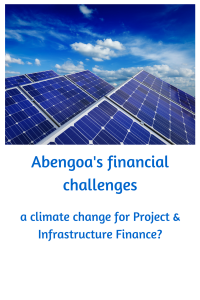An article in the Wall Street Journal in November 2015 (http://www.wsj.com/articles/spains-abengoa-files-for-creditor-protection-1448457865) stated “Spanish renewable energy and engineering firm Abengoa SA said on Wednesday that it is filing for preliminary creditor protection, an initial step that could lead to the largest bankruptcy case in the country’s history….”.
Abengoa’s specific financial challenges also come at a time when there is increased uncertainty in the financial markets including weakness in several major Emerging Markets….including markets in which Abengoa has major projects.
Although each company faces its own challenges, the reported financial difficulties of Abengoa have parallels with companies like Enron … high growth, complex organisational structures, extensive use of Joint Ventures and highly leveraged. So are the challenges facing Abengoa just company specific or are they reflecting broader issues that might impact Project and Infrastructure Finance?
Regardless of your views Abengoa’s situation raises a number of issues and possible consequences including:
The changing business models of many sponsors in the Power and Infrastructure area
In the Project and Infrastructure Finance area there has been growth in recent years of sponsors that are Infrastructure Funds, contracting / Concession companies, and Private Equity / financial firms that make extensive use of Project rather than Corporate Finance. Their business models vary from operating companies whose core business is specific to the relevant project sector.
Increasingly, with the rapid change in the energy supply markets, a number of traditional utility companies with a heavy investment in carbon intensive power technologies are also increasingly moving towards a business model involving developing and selling assets (either specific projects or business lines) and spin offs.
What is the effect of changing business models?
- Relative to “invest and hold” investors, sponsors with high leverage and employing a “develop and exit/refinance” business model are more exposed to business and financial risks when business and investment markets are unfavourable particularly if they have assumed short time frames for refinancing/ exits from projects. They may also have less incentive to support projects financed on a limited recourse basis should those projects face financial difficulties.
- In many cases financial investors (as opposed to operating companies) are likely to seek early exits from Project Finance transactions in order to boost investment returns.
- Infrastructure Funds also typically finance projects on a “project by project basis” with the consequence that there may be no or limited recourse to the Funds beyond the specific project being financed.
Consequence: The general impact of these “non-traditional” project sponsors that seek to limit recourse on Project Finance transactions, and changed business model for some traditional operators has generally been that there has been growth in more highly leveraged project investors and structures, with limited recourse, therefore increasing sponsor and project risk.
Is the financial position of the sponsor transparent and private equity vs operating companies?
Abengoa has a huge range of activities conducted through the parent company, subsidiaries (partly and wholly owned), associates and Joint Ventures. Additionally the company has a partial interest in a YieldCo where transactions have been originated by other parts of the Abengoa group which have ongoing operating relationships with the Yield Co.
Consequence: The huge number of subsidiaries, associates and Joint Ventures makes it difficult to analyse the interrelationships within the group and raises questions about the transparency of transactions and dependence on ongoing financial viability of groups that have substantial “off balance sheet” investment vehicles and operating commitments with those investment vehicles
What is the ongoing relationship between sponsors and their subsidiaries?
As stated above the interrelationship and terms and conditions of transactions within the Abengoa group are not clear from published financial information and the reported financial difficulties of the “Abengoa group” may have adverse consequences for the ongoing operation of specific projects, especially where the financial viability is weak.
Consequence: requirement to undertake more detailed due diligence of contracts with related parties
Corporate vs Project Finance debt and structural subordination
In groups like Abengoa there is debt at various levels within the group, a mixture of corporate and project specific debt and therefore issues relating to the structural subordination of debt at the parent company and other non-operating companies.
In such situations there are likely to be major restrictions on distributions of cash to the parent company and non-operating subsidiaries, as well as in respect of partly owned companies.
Consequence: greater attention to contractual and structural subordination issues
How are the construction risks being mitigated?
In general a principle of rating risks on Project Finance transactions is that, in the absence of credit enhancement, the pre completion rating will be capped at the rating level of the contractor.
Where the contractor is facing financial difficulties, the risk of loss is increased. In studies of Project Finance loans undertaken by Moody’s a conclusion is that losses are higher on projects that default during the construction period relative to those projects that are operational when the projects face difficulty.
Consequence: greater attention to contractor related financial and operating risks
Where projects are based on subsidies, investment tax credits and credit support such as offtake agreements and Export Credit Agency support what are the implications when sponsors face financial difficulties?
As a generalisation renewable energy projects and other infrastructure projects in areas like public transportation have been subsidised by governments, either for reasons of public policy and / or to support new technologies until they reach a level of technology advancement where they become competitive with existing operators.
In the event of a sponsor facing financial difficulty a key issue is whether subsidies/ tax credits may be clawed back/withheld and whether credit support /guarantees will be enforceable….both in legal and commercial terms.
Consequence: greater attention to the level of support from governments for new technologies, as well as increased due diligence on the validity of any credit support and subsidies/tax credits in event of non performance by a sponsor.
Has the availability of subsidies and competitive bidding resulted in the private sector undertaking projects that are unviable and weakened existing operators?
History has illustrated in the case of new technologies that risks are high at the early stages of development, especially when there are existing strong players in the relevant business sector.
New technologies often require financial support to make them viable until the level of transactions reach a critical mass. Even in areas where projects have been undertaken without government financial support, such as mobile phones, many projects were operating with far larger cash outflows than originally forecast inspite of far higher customer subscriptions than had been projected.
In the case of renewable energy, the availability of subsidies, investment tax credits and other forms of direct and indirect support such as long term offtake agreements from government owned utilities, may also have resulted in some projects being undertaken that are not financially viable or with low projected returns. In these cases, if the projects and / or their financial sponsors face difficulties, the continuing availability of the subsidies / support needs to be carefully examined.
In the case of Infrastructure, social infrastructure and transport projects have been large recipients of government support / assured payment flows (subject to Availability) either because of government policy or increased use of Project Finance based on Availability payments in sectors where the private sector has been unwilling to accept demand risks.
The effect of subsidies / support may therefore have resulted in bids of questionable financial viability. This may have facilitated development of sectors such as Renewable Energy and social infrastructure and transport. However failures of major sponsors / projects may have (and have had) financial consequences for Governments, and result in review of their financial support for both future and existing projects
Consequence: greater attention to the dependence of projects on subsidies and project support
Each company has its own features, and the outcome of Abengoa’s reported financial challenges are of course currently unknown but as a generalisation, financial difficulties being faced by a major sponsor are likely to result in increased due diligence on sponsors, underlying project risks and tightening of credit terms in the Project and Infrastructure Finance sector.







Leave A Comment